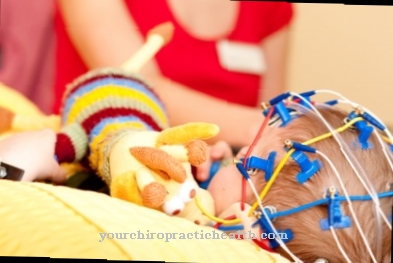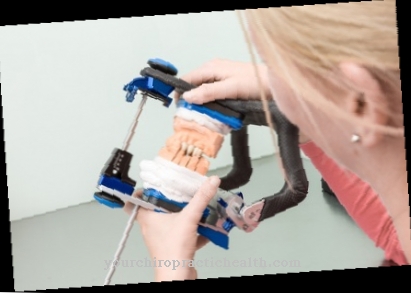To determine whether the eyes have enough tear fluid, the Schirmer test applied. Special strips of filter paper are used that soak up the liquid over a certain period of time.
If the eyes are too dry, the ophthalmologist can diagnose what is known as sicca syndrome. In this case, insufficient tear fluid is formed and there are also deficiencies in their composition. The cornea of the eye cannot be sufficiently moistened and protected. The Schirmer test can also detect Sjogren's syndrome, named after a Swedish doctor, in which the conjunctiva and mucous membranes in the area of the eyes are affected by the malfunction of the tear glands. The test strips usually measure five by 35 millimeters and have a corresponding scale.
What is the Schirmer test?
The litmus paper test method bears the name of the German ophthalmologist and university professor Otto Wilhelm Schirmer (1864-1917). He came from Greifswald and studied at the university there as well as in Munich and Freiburg.
In 1896, the doctor, who has now received his doctorate and qualified as a professor, took over the chair for ophthalmology in Greifswald. Schirmer later held teaching posts in Kiel and Strasbourg before moving to the United States and working in several New York clinics. The tear gland function test, first carried out in 1903, is still used today under Schirmer's name. Two different variants of the Schirmer test are common. In the Schirmer 1 procedure, a small test strip is carefully hooked into the lower conjunctival sac of both eyes.
The patient then closes his eyes and the filter paper absorbs the respective amount of tear fluid within five minutes. When the strip is full of liquid, it changes color. The ophthalmologist can use this color to make his assessments. However, this variant is only used very rarely. Schirmer 2 is used much more frequently. Here both eyes are locally anesthetized and, regardless of any possible irritation, indicate the amount of tear fluid being secreted without any relevant external influences such as through the filter paper. If the soaked section on the test strip is shorter than ten millimeters, the tear flow is too low.
Five millimeters or less of a wet spot indicate an urgent case of dry eyes. The ophthalmologist will then examine whether this deficiency is due to any inflammation of the conjunctiva or other areas of the eye. However, he must be aware that the test results may be inaccurate. The eyes may be so irritated during the test that they water more than usual and thus the risk of dehydration remains undetected. In addition, a patient should not wear contact lenses two hours after the Schirmer test in order to protect the eyes.
Function, effect & goals
The Schirmer test is carried out when the eyes are red and cause a burning sensation. The eyes can also be dehydrated if enough tear fluid is produced, but the composition is not in balance.
It often happens that the tear fluid, which is made up of three layers, lacks its oily components and thus the protection of the eye deteriorates. In addition, the tear water is no longer evenly distributed. However, the Schirmer test is not suitable for this examination. In addition, the Schirmer 2 has major problems with wearing contact lenses from a humidification distance of eight millimeters.
In such cases, the lenses are perceived as incompatible by the protective mechanisms of the eye. Corresponding reactions such as reddening, inflammation or excessive tearing are intensified if those affected work often and for a long time at the computer screen, if they encounter an uncomfortable room climate or if there is strong, gusty wind. As soon as the eyes become noticeably dry or even begin to redden, ophthalmologists and opticians recommend wearing glasses instead of contact lenses.
You can find your medication here
➔ Medicines for eye infectionsRisks, side effects & dangers
If the Schirmer test delivers a positive result, various diseases can be the cause of this insufficient production of tear fluid. Sjogren's syndrome is an immunodeficiency in which stray immune cells attack the tear and salivary glands. This disease occurs mainly in postmenopausal women.
Trachoma, an inflammation of the eyes caused by bacteria, continues to affect tear production. Blindness can even develop here if there is no timely medical intervention. Various types of facial paralysis can also affect the tear fluid supply to the eye, insofar as they affect the muscles concerned. Dry eyes are often the result of diseases such as diabetes, chronic rheumatism or thyroid malfunction. Even a room with too little humidity can lead to dry and sore eyes in sensitive people.
Anyone who suffers from this is well advised to use humidifiers that are installed in these rooms. With frequent and intensive work on the screen, longer breaks should be taken regularly to relieve the eyes a little. Incidentally, the Schirmer test is also carried out if a defective vision has developed that should be remedied by inserting contact lenses. The test also fulfills an important task in veterinary medicine, because dogs, horses and cattle in particular often suffer from dry eyes. The test procedure on animals is basically the same as on humans and absolutely painless for four-legged friends.

























.jpg)

.jpg)
